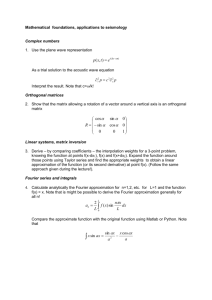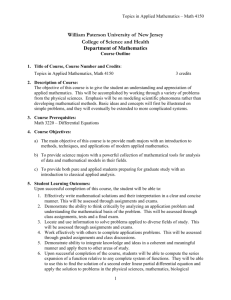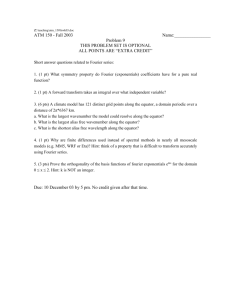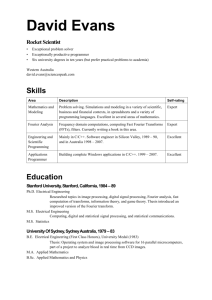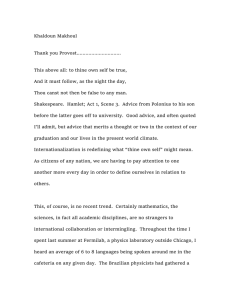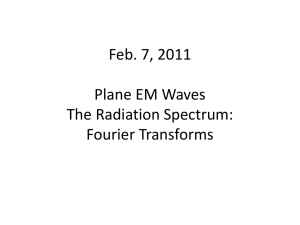Math 216 - University of Michigan–Dearborn
advertisement
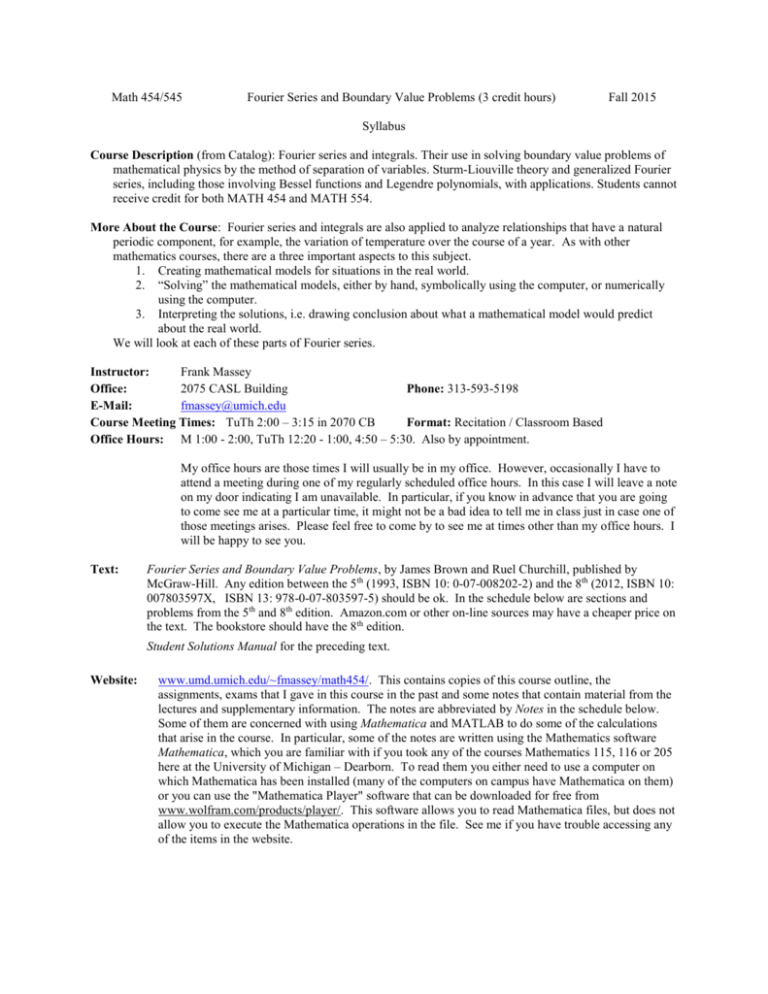
Math 454/545 Fourier Series and Boundary Value Problems (3 credit hours) Fall 2015 Syllabus Course Description (from Catalog): Fourier series and integrals. Their use in solving boundary value problems of mathematical physics by the method of separation of variables. Sturm-Liouville theory and generalized Fourier series, including those involving Bessel functions and Legendre polynomials, with applications. Students cannot receive credit for both MATH 454 and MATH 554. More About the Course: Fourier series and integrals are also applied to analyze relationships that have a natural periodic component, for example, the variation of temperature over the course of a year. As with other mathematics courses, there are a three important aspects to this subject. 1. Creating mathematical models for situations in the real world. 2. “Solving” the mathematical models, either by hand, symbolically using the computer, or numerically using the computer. 3. Interpreting the solutions, i.e. drawing conclusion about what a mathematical model would predict about the real world. We will look at each of these parts of Fourier series. Instructor: Frank Massey Office: 2075 CASL Building Phone: 313-593-5198 E-Mail: fmassey@umich.edu Course Meeting Times: TuTh 2:00 – 3:15 in 2070 CB Format: Recitation / Classroom Based Office Hours: M 1:00 - 2:00, TuTh 12:20 - 1:00, 4:50 – 5:30. Also by appointment. My office hours are those times I will usually be in my office. However, occasionally I have to attend a meeting during one of my regularly scheduled office hours. In this case I will leave a note on my door indicating I am unavailable. In particular, if you know in advance that you are going to come see me at a particular time, it might not be a bad idea to tell me in class just in case one of those meetings arises. Please feel free to come by to see me at times other than my office hours. I will be happy to see you. Text: Fourier Series and Boundary Value Problems, by James Brown and Ruel Churchill, published by McGraw-Hill. Any edition between the 5th (1993, ISBN 10: 0-07-008202-2) and the 8th (2012, ISBN 10: 007803597X, ISBN 13: 978-0-07-803597-5) should be ok. In the schedule below are sections and problems from the 5th and 8th edition. Amazon.com or other on-line sources may have a cheaper price on the text. The bookstore should have the 8th edition. Student Solutions Manual for the preceding text. Website: www.umd.umich.edu/~fmassey/math454/. This contains copies of this course outline, the assignments, exams that I gave in this course in the past and some notes that contain material from the lectures and supplementary information. The notes are abbreviated by Notes in the schedule below. Some of them are concerned with using Mathematica and MATLAB to do some of the calculations that arise in the course. In particular, some of the notes are written using the Mathematics software Mathematica, which you are familiar with if you took any of the courses Mathematics 115, 116 or 205 here at the University of Michigan – Dearborn. To read them you either need to use a computer on which Mathematica has been installed (many of the computers on campus have Mathematica on them) or you can use the "Mathematica Player" software that can be downloaded for free from www.wolfram.com/products/player/. This software allows you to read Mathematica files, but does not allow you to execute the Mathematica operations in the file. See me if you have trouble accessing any of the items in the website. Assignment and Grading Distribution – Math 454 (undergraduate version of course): 3 Midterm Exams (100 points each) 300 Assignments 100 Final Exam (100 points) 100 Total 500 Assignment and Grading Distribution – Math 554 (graduate version of course): 3 Midterm Exams (100 points each) 300 Assignments 100 Project 50 Final Exam (100 points) 100 Total 550 Notes regarding Assignments and Exams: You may continue submitting solutions to the problems on the assignments until you have accumulated 100 points. 100 points is the maximum that your assignments may count toward your grade. The assignments can be found on CANVAS and at www.umd.umich.edu/~fmassey/math454/Assignments/. Students taking Math 554 need to do a project where they find an article in a journal where the mathematics in this course has been applied to some other subject, submit a report on the contents of this article, and do something that extends what is done in the article. This will count 50 points. More details can be found on CANVAS and at www.umd.umich.edu/~fmassey/math454/Assignments/. See me if you need help finding a journal article to read and report on. The dates of the exams are on the schedule below. All exams are closed book, but a formula sheet will be provided. You may find that your calculator can do some of the problems on the exams. If this is so, you still need to show how to do the problem by hand, even if you use a calculator to check your work. In the schedule below are some suggested problems for you to work on. Some of these problems are representative of what will be on the exams, while others are simply to help you fix the concepts in your mind or prepare you to do other problems. Work as many problems as time permits and ask for help (in class or out) if you can’t do them. A copy of the formula sheet is at www.umd.umich.edu/~fmassey/math454/Exams/Formulas.doc. No make-up exams unless you are quite sick. Grading Scale: On each exam and the assignments (and the project for Math 554) I will look at the distribution of scores and decide what scores constitute the lowest A-, B-, C-, D-. The lowest A- on each of these items will be added up and the same for B-, C-, D-. The lowest A, B+, B, C+, D+, D will be obtained by interpolation. For example, the lowest B is 1/3 of the way between the lowest B- and the lowest A-, etc. All your points will be added up and compared with the lowest scores necessary for each grade. For example, if your total points falls between the lowest B+ and the lowest A- you would get a B+ in the course. This information is in the file YourGrade which is located in the course website at www.umd.umich.edu/~fmassey/math454/. After each exam and assignment is graded this information will be updated and you should be able to see how you stand. You can find out what scores I have recorded for you by going to CANVAS, selecting Math 454 or Math 545 and clicking on Grades on the left. If possible, check your grades after each exam and assignment to see that they were entered correctly. 2 Withdrawal: Tuesday, November 10 is the last day to withdraw from the course. Course Outline: B8 = Brown & Churchill, 8th edition B5 = Brown & Churchill, 5th edition Notes = Notes in the course website online Dates 9/10 9/15 Section(s) B8: §60, 61 B5: §11 Notes: §1.1-1.4 Topics and Suggested Problems Orthogonality of vectors and functions, trigonometric identities, orthogonality of sines and cosines. B8: §2, 3 B5: §12, 13 Notes: §1.5 1 Fourier cosine series: f(x) = a0 + an cos(nx) for 0 < x < where a0 = f(x) dx and B8: §61 #1, 2, 3 B5: §11 #4, 5, 6 these problems are the same in the two editions n=1 an = 2 0 f(x) cos(nx) dx for n = 1, 2, …. Examples. 0 Exam 1, W 93 #5 B8: §5 #1a , 2a, 3a, 4, 6 same as B5: §14 #1a , 2a, 4a, 3a, 8 9/15 B8: §4, 5 B5: §14 Notes: §1.6 2 Fourier sine series: f(x) = bn sin(nx) for 0 < x < where bn = f(x) sin(nx) dx. n=1 0 Examples. Exam 2, W 93 #1 B8: §5 #1b , 2b, 3b, 5 same as B5: §14 #1b , 2b, 4b, 5 9/17 B8: §6, 7 B5: §15 Notes: §1.7-1.8 Fourier series: f(x) = a0 + (an cos(nx) + bn sin(nx)) for - < x < where n=1 a0 = - - 1 1 1 f(x) dx and an = f(x) cos(nx) dx bn = f(x) sin(nx) dx for n = 1, 2, …. 2 - Examples, Even and odd functions, relationship to the cosine and sine series. B8: §6 #1, 2, 3, 4, 5, 6, 7 almost same as B5: §15 #1, 2, 3, 4, 5, 6, 7 9/22 B8: §8 B5: §21 Notes: §1.9 nx nx Fourier series on other intervals: f(x) = a0 + (an cos + bn sin c c ) for - c < x < c where a0 = c n=1 c -c -c 1 1 nx f(x) dx and an = c f(x) cos c dx 2c c bn = 1 nx f(x) sin c dx for n = 1, 2, …. . c -c c nx 1 f(x) = a0 + an cos f(x) dx and c for 0 < x < c where a0 = c n=1 an = 2 c 0 nx c dx for n = 1, 2, …. f(x) cos 0 c nx 2 nx f(x) = bn sin for 0 < x < c where bn = f(x) sin c c c dx. Examples. n=1 0 3 9/22, 24 B8: §2123, 26 B5: §1-3 Notes: §2.1-2.2 9/29 B8: §24, 25 B5: §4 Notes: §2.3—2.4 9/29 B8: §28, 29 B5: §5, 6 Notes: §2.5 B8: §30 B5: §8 Notes: §2.6 10/1 10/1, 6 B8: §32-37, 45 B5: §9, 25-30, 45 Notes: §3.2-3,2 10/8 B8: §39-42 B5: §32, 33 Notes: §3.3-3.4 10/8 10/13 10/15 10/20, 22 B8: §43, 44 B5: §34, 35 Notes: §3.5 B8: §10 B5: §16 Notes: §4.1 Exam 2, W 94 #1 Final exam, W 93 #2 Final exam, W 94 #2 B8: §8 #1a, 2, 4, 5, 8 almost same as B5: §21 #5a, 5b+6, 7, 8, 3 Derivation of the heat equation, initial and boundary value problems, Laplace's and Poisson's equation. Exam 1, W 93 #1 Exam 1, W 94 #1 B8: §23 #1 , 2, 3, §27 #1 , 2, 3 same as B5: §4 #1, 2, 3, 6, 8, 9 Cylindrical and spherical coordinates. Exam 1, W 93 #2, 3 Exam 1, W 94 #2, 3 B8: §25 #1, 2, §27 #4, 8 same as B5: §4 #4, 10, 11, 13 The wave equation: derivation, initial and boundary value problems. B8: §28 #1, 2, 3, §29 #1, 4, 8 same as B5: §5 #1, 2, 4, 6, 8, 12 D'Alembert's solution of the wave equation. Exam 1, W 93 #4 Exam 1, W 94 #4 Final exam, W 93 #1 Final exam, W 94 #1 B8: §30 #2, 3, 4 same as B5: §9 #5, 13, 14 Solution of differential equations using separation of variables, superposition and Fourier series. Exam 2, W 93 #4 Exam 1, W 94 #5 Exam 2, W 94 #3 B8: §34 #2-6, §37 #1, 3 same as B5: §9 #10 §28 #2, 3, 6, 8, 9, 10 Solution of some inhomogeneous problems. Exam 2, W 93 #5 Exam 2, W 94 #4 Exam 3, W 94 #1 Final exam, W 93 #4 Final exam, W 94 #3 B8: §39 #1-3, §40 #1, 3 §42 #1-4, 8-10 same as B5: §32 #1-3, 8, 9, §33 #1, 3-7, 10 Review for exam. Exam #1. Dirichlet problems for Laplace's equation. Exam 3, W 93 #1 B8: §43 #1, 4, §43 #1, 3 same as B5: §35 1, 3, 4, 8 The least squares property of Fourier series. Exam 2, W 93 #2 Exam 2, W 94 #2 Problem 1. Find c1, c2 and c3 so as to minimize 2 2 (x – c1 sin x – c2 sin 2x – c3 sin 3x) dx. 0 Problem 2. The Fourier cosine series of f(x) = - x on the interval 0 < x < is cos (2n - 1)x + . Using this and Bessel's inequality show that 2 4 (2n - 1)2 n-1 4 1 4 (2n - 1)4 96 . n-1 10/20, 22 B8: §11-14 B5: §18-20 Notes: §4.2 10/27, 29 B8: §50-54 B5: §51-55 11/3 11/5 11/3, 10 B8: §55-59 B5: §56-58 11/12, 17 B8: §80-90 B5: §59-67 11/17, 19 B8: §91-97 B5: §68-71 11/24 N: §1.1 Convergence of Fourier series. Exam 2, W 93 #3 B8: §14 #2-4, 6 same as B5: §20 #1-3, 6 Fourier integrals. Exam 3, W 93 #2 Exam 3, W 94 #2 Final exam, W 93 #5 Final exam, W 94 #4 B8: §53 #1-4, §53 #1, 4 same as B5: §§54 #2-5, §55 #1, 4 Review for exam. Exam #2. Applications of Fourier integrals to partial differential equations. Exam 3, W 93 #3 Exam ,3 W 94 #3 Final exam, W 93 #6 Final exam, W 94 #5 B8: §58 #1-3, 5 §59 #1-3 same as B5: §58 #3-8, 13 The heat equation in a disk, Bessel's equation, Bessel functions, definition in terms of power series, derivative and integral formulas, zeros, orthogonality properties. B8: §82 #8, 9, §83 #1 same as B5: §62 #3, 14, 15 Application of Bessel functions to the solution of the heat and wave equation in regions with radial symmetry. Exam 3, W 93 #4 Final exam, W 93 #7 Final exam, W 94 #6 B8: § same as B5: § Complex form of Fourier series. f(x) = An einx for - < x < where n=- An = 1 f(x) e-inx dx for n = 0, 1, 2, …. Examples 2 - 11/24 12/1 12/3 12/8 - 10 Review for exam. Exam #3. Finite Fourier series Applications of finite Fourier series to discrete data. 12/10 Review for final. Tuesday, December 15, 3:00 – 6:00 p.m. Final Exam. Mathematics Program Goals: 1. Increase students’ command of problem-solving tools and facility in using problem-solving strategies, through classroom exposure and through experience with problems within and outside mathematics. 2. Increase students’ ability to communicate and work cooperatively. 3. Increase students’ ability to use technology and to learn from the use of technology, including improving their ability to make calculations and appropriate decisions about the type of calculations to make. 4. Increase students’ knowledge of the history and nature of mathematics. Provide students with an understanding of how mathematics is done and learned so that students become self-reliant learners and effective users of mathematics. 5 Course Objectives: After finishing this course students should be able to 1. Model situations in the real world with differential equations 2. Solve a variety of differential equations by hand 3. Use mathematical software to solve a variety of differential equations 4. Use the solution of differential equations to answer questions about the real world situation the equations model University Attendance Policy A student is expected to attend every class and laboratory for which he or she has registered. Each instructor may make known to the student his or her policy with respect to absences in the course. It is the student’s responsibility to be aware of this policy. The instructor makes the final decision to excuse or not to excuse an absence. An instructor is entitled to give a failing grade (E) for excessive absences or an Unofficial Drop (UE) for a student who stops attending class at some point during the semester. Academic Integrity The University of Michigan-Dearborn values academic honesty and integrity. Each student has a responsibility to understand, accept, and comply with the University’s standards of academic conduct as set forth by the Code of Academic Conduct (http://umdearborn.edu/697817/), as well as policies established by each college. Cheating, collusion, misconduct, fabrication, and plagiarism are considered serious offenses and violations can result in penalties up to and including expulsion from the University. Disability Statement The University will make reasonable accommodations for persons with documented disabilities. Students need to register with Disability Resource Services (DRS) every semester they are enrolled. DRS is located in Counseling & Support Services, 2157 UC (http://www.umd.umich.edu/cs_disability/). To be assured of having services when they are needed, students should register no later than the end of the add/drop deadline of each term. If you have a disability that necessitates an accommodation or adjustment to the academic requirements stated in this syllabus, you must register with DRS as described above and notify your professor. Safety All students are strongly encouraged to register in the campus Emergency Alert System, for communications during an emergency. The following link includes information on registering as well as safety and emergency procedures information: http://umemergencyalert.umd.umich.edu/ Finally, all students are also encouraged to program 911 and UM-Dearborn’s Public Safety phone number (313) 593-5333 into personal cell phones. In case of emergency, first dial 911 and then if the situation allows call UM-Dearborn Public Safety. 6
